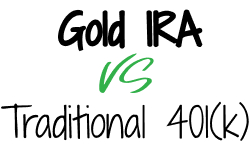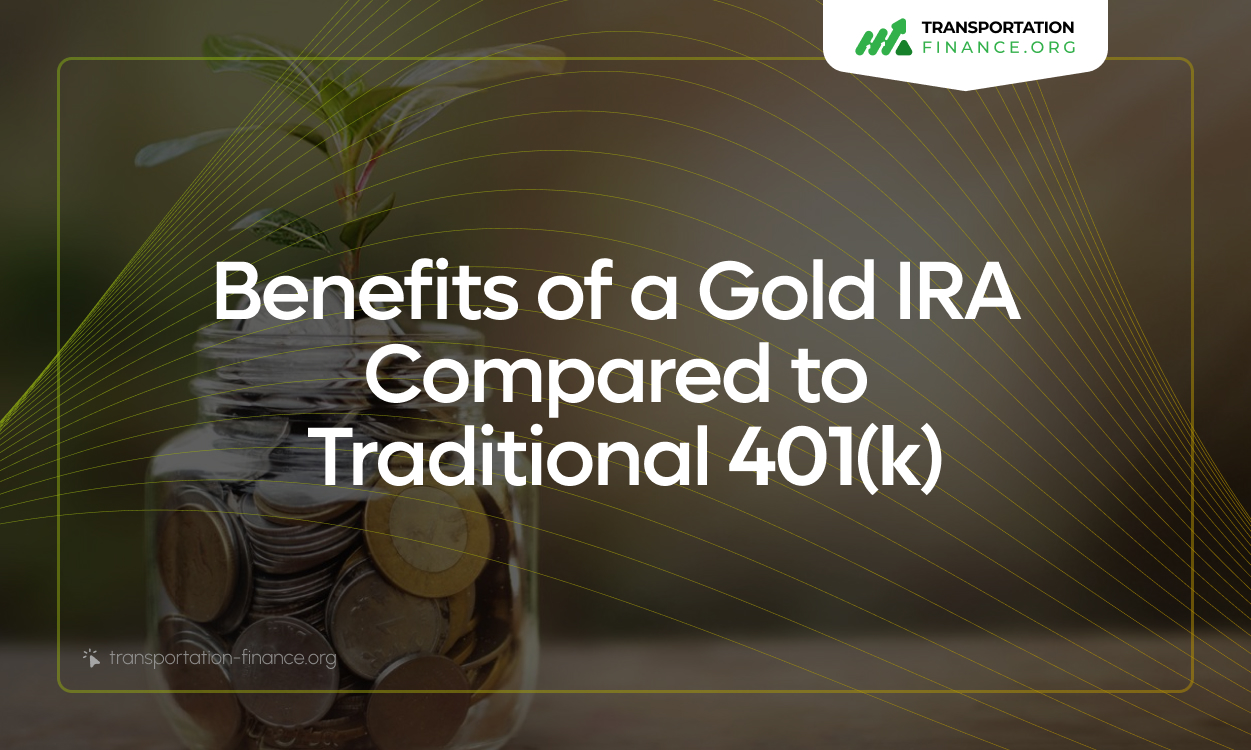Disclaimer: The companies mentioned in this report may offer compensation to us, without any charge to our readers. This is how we keep our reporting free for readers. Our selection of companies is determined by compensation and rigorous analysis.
Considering investing in a Gold IRA but unsure how it compares to a Traditional 401(k)?
We break down the key differences between the two retirement investment options.
From the benefits of diversification and protection against inflation with a Gold IRA to the employer matching contributions and tax-deferred growth of a Traditional 401(k), we explore which one may be the right choice for you based on your age, retirement goals, risk tolerance, and personal financial situation.
Stay tuned to make an informed decision for your future financial security.
Our team has spent years researching every company in the precious metals industry. Save your time and use our research ⟶
Hand picked top 5 trusted and best reviewed companies
Protect Your Retirement
Claim Your FREE Gold Kit Now
Key Takeaways
What is a Gold IRA?
A Gold IRA is an Individual Retirement Account that allows investors to hold physical gold and other precious metals within their retirement portfolio. It provides a unique opportunity for individuals to diversify their investments beyond traditional assets like stocks and bonds.

Unlike traditional IRAs that typically focus on conventional investment options, a Gold IRA offers a tangible hedge against economic uncertainties and inflation. By investing in physical gold, individuals can protect their retirement savings from market volatility and currency devaluation.
One of the key benefits of a Gold IRA is the tax advantages it provides. Investors can enjoy tax-deferred growth on their precious metal investments, allowing their retirement savings to grow more efficiently over time.
Having gold and precious metals in a retirement portfolio serves as a reliable inflation hedge. Gold tends to retain its value and even appreciate during times of economic instability, making it a valuable asset for long-term wealth preservation.
How Does a Gold IRA Work?
A Gold IRA works by allowing individuals to allocate a portion of their retirement savings into physical gold or other precious metals. Investors typically work with a reputable dealer to purchase the metals, which are then stored securely on their behalf.
Investment strategies for a Gold IRA involve evaluating market trends, considering diversification with other assets, and assessing risk tolerance. When setting up a Gold IRA, individuals need to carefully research and select a trustworthy dealer. Financial planning plays a crucial role in determining the percentage of retirement savings to allocate to precious metals.
Precious metals can act as a hedge against inflation and economic uncertainty, offering stability to a retirement portfolio. Choosing a reliable dealer is essential to ensure secure storage and transparent pricing for the metals
What is a Traditional 401(k)?
A Traditional 401(k) is an employer-sponsored retirement plan that allows employees to contribute a portion of their pre-tax income towards their retirement savings. Employers often match a percentage of these contributions, providing additional benefits to employees.
One of the key advantages of a Traditional 401(k) is the tax-deferred growth it offers. This means that your contributions grow tax-free until you withdraw them in retirement, allowing your savings to potentially accumulate more over time.

These plans typically come with a variety of investment options, ranging from stocks to bonds to mutual funds, providing you with the financial flexibility to tailor your portfolio to your risk tolerance and retirement goals.
How Does a Traditional 401(k) Work?
A Traditional 401(k) works by allowing employees to contribute a portion of their pre-tax income towards retirement savings, which grows tax-deferred until withdrawal. Employers may match contributions, enhancing the growth potential of the account.
In a Traditional 401(k), the contributed amount is deducted from the employee’s taxable income, reducing the immediate tax burden. This deduction offers a valuable opportunity to lower taxable income and potentially fall into a lower tax bracket.
The tax-deferred growth means that any interest, dividends, or capital gains earned within the 401(k) account are not taxed until withdrawal during retirement, allowing the contributions to compound over time without annual tax consequences. This feature can significantly boost the overall returns in comparison to taxable investment accounts.
Protect Your Retirement
Claim Your FREE Gold Kit Now
What Are the Benefits of a Gold IRA?
Investing in a Gold IRA offers numerous benefits, including acting as a hedge against inflation, providing the potential for tax-free growth, and offering diversification benefits beyond traditional investments like stocks.
One of the key advantages of holding a Gold IRA is its ability to mitigate risks associated with inflation.

Gold has historically maintained its value during economic downturns, making it a reliable store of wealth. The tax advantages of a Gold IRA allow investors to potentially enjoy tax-free growth on their investments, helping to maximize returns over time.
Unlike typical investment options that may be subject to market volatility, a Gold IRA offers stability and acts as a way to diversify your investment portfolio. By including gold in your retirement savings, you can reduce overall risk and protect your wealth against uncertainties in the financial markets.
Diversification of Portfolio
Diversifying your portfolio through a Gold IRA can enhance financial security by spreading risk across different asset classes. It allows investors to weather market fluctuations and economic uncertainties more effectively.
When considering investment strategies for a Gold IRA, individuals often seek investment guidance to make informed decisions. By diversifying with various assets like gold, stocks, and bonds, one can mitigate the impact of fluctuations specific to a single asset class.
Maintaining a well-balanced mix in the portfolio helps in achieving long-term financial benefits and stability.
Protection Against Inflation
A Gold IRA serves as a valuable hedge against inflation, preserving the purchasing power of one’s retirement savings over time. This protection against inflation can help retirees maintain their standard of living in the face of rising prices and costs.
Investing in physical gold within a retirement account offers various tax advantages. Not only does holding gold in a Gold IRA provide protection from estate taxes, but it also allows for tax reductions and potentially lowers one’s tax bracket.
By incorporating gold into a retirement portfolio, individuals can diversify their assets while taking advantage of the tax perks associated with this precious metal, ultimately securing a more robust financial future.
Potential for Higher Returns
Investing in a Gold IRA can offer the potential for higher returns due to the historical appreciation of precious metals over time. This growth potential, combined with compound interest, can significantly boost the value of your retirement savings.
When you invest in a Gold IRA, it’s not just about the immediate returns; it’s about setting yourself up for long-term financial success. The investment component of a Gold IRA provides a hedge against inflation and economic uncertainties, diversifying your portfolio. By understanding this crucial aspect of financial literacy, individuals can make informed decisions about their retirement planning.
Unlike many employer-sponsored retirement plans, a Gold IRA puts you in control of your investments, offering greater flexibility and the potential for substantial growth. Leveraging compound interest in this context can lead to exponential wealth accumulation, highlighting the benefits of proactive retirement planning.
Hedge Against Stock Market Volatility
A Gold IRA acts as a hedge against stock market volatility, providing stability and security during turbulent market conditions.
By diversifying their investment portfolio with physical gold, investors can reduce their exposure to market risks and secure a portion of their assets in a tangible form. This strategy offers a valuable shield to financial resources that have been diligently saved for retirement, safeguarding them from the unpredictable nature of stocks.
The option to roll over existing retirement accounts into a Gold IRA without incurring immediate withdrawal penalties provides flexibility and peace of mind for those looking to align their financial goals with a more stable and resilient investment approach.
What Are the Benefits of a Traditional 401(k)?
A Traditional 401(k) offers several advantages, including the potential for tax-deferred growth on contributions, the opportunity for employer matching contributions, and access to financial advice and guidance.
One of the key benefits of a Traditional 401(k) is the tax advantages it provides. By contributing to this employer-sponsored retirement plan, individuals can reduce their taxable income, potentially lowering their overall tax situation. This means that the amount contributed to the 401(k) is deducted from the individual’s taxable income for that year, leading to immediate tax savings.
In addition, many employers offer matching contributions, which can significantly boost retirement savings. When an employer matches a portion of the employee’s contributions, it’s essentially free money that goes straight into the retirement account, helping to accelerate the growth of the nest egg.
Employer Matching Contributions
One of the key benefits of a Traditional 401(k) is the opportunity for employer matching contributions, where the employer matches a percentage of the employee’s contributions. This matching feature helps employees reach their retirement goals faster.
Employer matching contributions in a Traditional 401(k) play a vital role in securing a stable financial future for individuals. By incentivizing employees to save for retirement, these contributions not only boost the growth of retirement savings but also serve as a powerful tool for building long-term financial security.
Matched contributions have a significant impact on reducing financial strain during unexpected circumstances, such as financial emergencies. The additional funds provided by the employer can act as a safety net, offering a cushion against unforeseen expenses, thus contributing to overall financial resilience.
When employees contribute to a 401(k) account with matched contributions, they may also benefit from reduced current income taxes as these contributions are often tax-deferred. This can help individuals stay in a lower tax bracket and optimize their tax savings, consequently enhancing their overall financial position.
Tax-deferred Growth
The tax-deferred growth feature of a Traditional 401(k) allows contributions to grow without being taxed until withdrawal. This tax-deferral can benefit individuals by reducing their current tax liabilities and supporting their financial needs in retirement.
By deferring taxes until withdrawal, individuals can maximize the growth potential of their retirement savings, allowing their contributions to compound over time. This can result in a significantly larger retirement nest egg compared to standard taxable investment accounts.
The tax deductions that come with contributing to a Traditional 401(k) can help individuals lower their taxable income during their working years, providing more disposable income to handle financial emergencies or invest in other areas.
Accessibility of Funds
A Traditional 401(k) provides accessibility to funds in retirement, allowing individuals to make withdrawals based on their needs. While withdrawals are subject to taxes, the tax benefits during the contribution phase can support a more secure financial future.
These tax-deferred savings can be used for various purposes beyond retirement planning, such as estate planning. By understanding the rules and implications of accessing funds from a Traditional 401(k), individuals can strategically manage their withdrawals to potentially reduce taxes and maximize their savings.
This flexibility not only aids in immediate financial needs but also plays a significant role in long-term wealth preservation. Planning ahead and utilizing the provisions of a Traditional 401(k) wisely can lead to effective tax reductions and solidify one’s financial position in retirement.
What Are the Differences Between a Gold IRA and Traditional 401(k)?
While both a Gold IRA and a Traditional 401(k) offer retirement savings options, they differ in terms of the types of investments allowed, the tax implications for contributions and withdrawals, and the accessibility of funds during retirement.
One of the key distinctions between a Gold IRA and a Traditional 401(k) lies in the investment choices available. A Gold IRA allows individuals to invest in physical precious metals such as gold, silver, platinum, and palladium, providing diversification beyond traditional stocks and bonds.

On the other hand, a Traditional 401(k) typically offers a range of investment options, including mutual funds, stocks, and bonds. Although this provides diversity, it may not include the option to directly invest in precious metals, which can be a limiting factor for those seeking to hedge against economic uncertainties.
Types of Investments Allowed
Gold IRA allows investments in physical gold and precious metals, offering a tangible asset within the retirement account. In contrast, a Traditional 401(k) typically includes a range of investment options such as stocks, bonds, and mutual funds.
Investing in physical gold through a Gold IRA can serve as a hedge against economic uncertainties, as precious metals tend to retain their value over time. This tangible asset can help diversify your retirement portfolio, adding a layer of stability.
On the other hand, a Traditional 401(k) provides a broader array of investment choices, which can cater to different risk tolerances and investment preferences. Understanding how these options align with your long-term financial goals and fit into your overall estate planning strategy is crucial in optimizing your retirement savings.”
Tax Implications
Gold IRA contributions are often made with after-tax dollars, while Traditional 401(k) contributions are typically pre-tax, affecting the tax bracket of the investor during the contribution phase and in retirement.
Contributing to a Gold IRA can provide the benefit of potentially tax-free income upon withdrawal, as the taxes have already been paid on the contributions. This means that any gains made on the investment are not subject to immediate taxation, offering investors valuable tax perks.

On the other hand, Traditional 401(k) contributions are tax-deferred, meaning investors do not pay taxes on the contributed amount until withdrawal. While this can lower an investor’s tax liability in the short term, they will be taxed on both the contributions and their earnings upon withdrawal.
Accessibility of Funds
Gold IRAs offer access to physical assets like gold and precious metals, providing a tangible investment for retirement. Traditional 401(k) accounts, on the other hand, offer a diverse range of investment options to support various investment strategies.
Regarding fund accessibility, Gold IRAs are known for their stability and potential to act as a hedge against economic uncertainties. Investors often turn to Gold IRAs for extra financial security and to diversify their portfolios beyond traditional investments. On the contrary, Traditional 401(k)s are more widely recognized for their tax benefits and diverse investment options, making them suitable for those seeking a blend of growth and stability.
Which One is Right for You?
Determining whether a Gold IRA or a Traditional 401(k) is right for you depends on factors like your age, retirement goals, risk tolerance, and personal financial situation. Assessing these aspects can help you make an informed decision about the most suitable retirement savings option.
Regarding financial planning for retirement, understanding the differences between a Gold IRA and a Traditional 401(k) is crucial. Your age plays a significant role in this decision-making process as it dictates your investment timeline and risk appetite.
Younger individuals may opt for a Gold IRA to capitalize on its potential long-term growth, while those nearing retirement might prefer the stability of a Traditional 401(k). Consider your investment strategies carefully to align them with your desired retirement lifestyle.
Age and Retirement Goals
When deciding between a Gold IRA and a Traditional 401(k), consider your age and retirement goals. Younger investors may benefit from the growth potential of a Gold IRA, while those closer to retirement may prefer the stability of a Traditional 401(k).
As you assess your options, remember that age plays a significant role in shaping your investment decisions. Younger individuals often have a longer time horizon, allowing them to take advantage of the potential higher returns associated with a Gold IRA.
On the other hand, individuals nearing retirement may prioritize preserving their wealth and opt for the more conservative approach offered by a Traditional 401(k).
Being mindful of your retirement strategy is crucial, especially when considering factors like free money from employer contributions and ensuring your investment choices align with your long-term financial objectives.
Risk Tolerance
Assessing your risk tolerance is crucial in deciding between a Gold IRA and a Traditional 401(k). Individuals comfortable with market fluctuations and seeking higher returns may opt for a Gold IRA, while those prioritizing stability might prefer a Traditional 401(k).
One significant factor affected by risk tolerance is the lengthy timeframe of investment. Those with a higher risk tolerance are more likely to invest for the long term, as they are willing to ride out market fluctuations in pursuit of potentially higher gains. On the other hand, individuals with a lower risk tolerance may prioritize stability over potentially higher returns, leading them to choose investments with less volatility.
Personal Financial Situation
Your personal financial situation plays a significant role in the decision between a Gold IRA and a Traditional 401(k). Consider factors like your tax situation, investment strategy, and current financial circumstances to determine the retirement savings vehicle that best suits your needs.
Regarding assessing your tax situation, it’s essential to evaluate how withdrawals from a Gold IRA or a Traditional 401(k) will be taxed both now and in the future. Withdrawal taxes can significantly impact your overall return on investment, so understanding the tax implications of each account type is crucial.
Choosing a reliable dealer is paramount when considering a Gold IRA. Conduct thorough research and ensure that the dealer you select has a solid reputation and a history of trustworthy transactions.
Aligning your chosen account with your long-term financial goals is fundamental. Your retirement goals should dictate whether a Gold IRA, with its focus on precious metals, or a Traditional 401(k), with its more conventional investment options, is better suited to help you achieve financial security in your later years.
Protect Your Retirement
Claim Your FREE Gold Kit Now
Frequently Asked Questions
What is a Gold IRA and how does it differ from a Traditional 401(k)?
A Gold IRA, also known as a Precious Metals IRA, is a retirement account that allows individuals to invest in physical precious metals such as gold, silver, platinum, and palladium. Unlike a Traditional 401(k), which is typically invested in stocks, bonds, and mutual funds, a Gold IRA offers a tangible asset that can act as a hedge against market volatility and inflation.
What are the benefits of having a Gold IRA compared to a Traditional 401(k)?
One of the main benefits of a Gold IRA is its ability to diversify your retirement portfolio. Gold has historically held its value and can act as a hedge against economic downturns and inflation. Additionally, a Gold IRA offers tax benefits, such as tax-deferred growth and the ability to withdraw funds without penalty for certain qualified distributions.
What are the risks associated with a Gold IRA?
As with any investment, there are some risks associated with a Gold IRA. The value of gold can fluctuate, and if it decreases in value, it can impact the overall value of your retirement account. Additionally, there may be fees associated with purchasing and storing physical gold, so it’s important to research and understand these costs before investing.
Can I transfer funds from my Traditional 401(k) to a Gold IRA?
Yes, it is possible to transfer funds from a Traditional 401(k) or other retirement account into a Gold IRA. This process, known as a rollover, allows you to move funds directly from one retirement account to another without incurring any taxes or penalties.
Are there any restrictions on when I can withdraw money from a Gold IRA?
The IRS has specific rules and regulations regarding when and how you can withdraw funds from a Gold IRA. Generally, you must be at least 59 ½ years old to make penalty-free withdrawals from a Gold IRA. However, there are certain exceptions for early withdrawals, such as for qualified medical expenses or first-time home purchases.
How do I get started with a Gold IRA?
To open a Gold IRA, you will need to find a reputable custodian who specializes in precious metals IRAs. They will help you set up the account and assist with the rollover or transfer of funds from your existing retirement account. It’s important to do your research and choose a reputable custodian to ensure the security of your investment.

I’m Bob Smithfield, your guide to making smart, safe investments. Here, I share financial insights and strategies that help you navigate the complex world of finance with confidence.
My goal is to provide you with the information and tools you need to make informed decisions about your finances.
